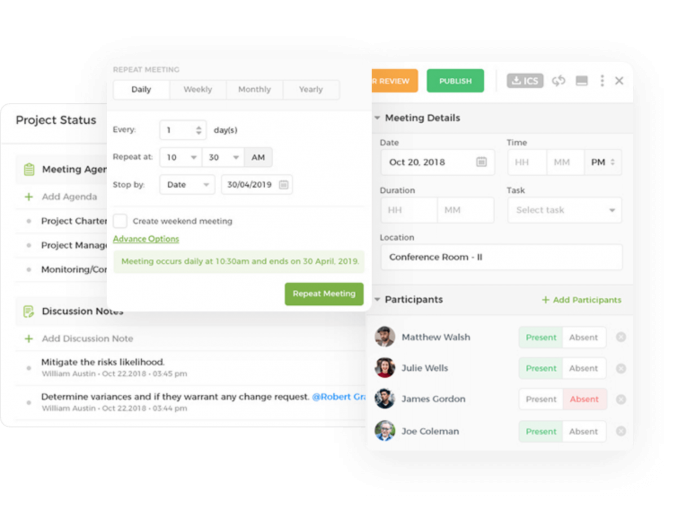Sprints are an effective project management methodology with which you can get better results at a faster pace. Sprints are planned before a project officially sets sailing. But what if you could improve the sprints for better results?
Enter Sprint retrospectives.
What is Sprint Retrospective?
A sprint retrospective is a meeting where the entire team sits together and analyzes the team’s performance in the past sprints and comes up with strategies to improve performance in the upcoming sprints.
The meeting includes all the team members i.e., scrum masters, product developers, and the product owner.
Sprint retrospectives are not only a great way of looking into your performance in previous sprints but are also an efficient way of bringing all the members of the team on the same page.
Communication during the spring retrospective can help team members identify their shortcomings, find solutions to any issues they are facing or just enhance their performance with feedback obtained in the sprint retrospective.
These meetings can also help team members understand their roles and responsibilities as well as the burden on other members of the team. With regular sprint retrospectives, team members can always stay in the loop.
Agenda of Sprint Retrospectives
What is the sprint retrospective meeting agenda? The main retrospective meeting agenda of teams is to analyze performance in the previous sprint and identify any gaps or issues. Team members discuss problems (if they encountered any), challenges they faced, etc.
Different teams can have different retrospective meeting agendas but the main purpose of a sprint retrospective is to improve performance by analyzing work in the last sprint.
Gaining insight into previous sprints can help plan better for future sprints. Teams can, then, look for ways to amplify their performance and improve their productivity.
Some of the questions that can be discussed during a Sprint retrospective meeting are:
- How did the previous sprint turn out?
- Did you encounter any problems?
- How did you solve challenges (if any)?
- What tools and techniques proved to be useful?
- What can be improved in the upcoming sprints?
- What are your expectations for the next sprint?
Getting the answers to these questions can certainly help you enhance your performance for future runs.
Why Do We Conduct Sprint Retrospectives?
What are the sprint retrospective’s benefits? A sprint retrospective can be your way of identifying issues and improving performance for the future. Here are a few of its most noticeable benefits for teams:
- Helps teams analyze their performance in the last sprint. They identify the good points as well as the bad points and then work on ways to eliminate the gaps and enhance the good points.
- The analysis allows teams to identify their weaknesses in the last sprint, which can then help them make better decisions for the future.
- The meeting helps teams carve out a better plan that can add to their productivity and efficiency.
- With all the team members gathered in one place, you can get insights into the processes and gather a lot of ideas to improve the working of the team.
- A retrospective meeting culminates in a practical decision that will add to the growth of your business in the long run.
- The meetings can also be a way of analyzing and comparing your performance with the past, and making changes wherever necessary to improve your productivity.
A Few Misgivings About Sprint Review and Sprint Retrospectives
The difference between a sprint review, and a sprint retrospective might not be that apparent considering the very similar but confusing names. In fact, both the meetings are as different as night and day. Here are a few differences that will clear the concept for you.
A sprint review is an external meeting wherein stakeholders are involved. A sprint review showcases the completed work to the stakeholders and is usually held before the sprint retrospective.
A sprint retrospective, in contrast, involves the team members only and focuses on analyzing the gaps in the previous sprints and coming up with strategies to improve performance in upcoming sprints. This meeting is held before the planning for the next sprint starts.
Featured Readings:
A Little Insight into Sprint Retrospectives:
What is sprint retrospective, and how long is it? When does it occur? How many people are involved in a sprint retrospective? These questions might pop up in your head when you look at the sprint retrospective.
Well, here are the answers.
As we mentioned earlier, a sprint retrospective is a meeting wherein team members discuss the gaps in the previous sprint and work out ways to better their performance in the next ones. As for how long a meeting is, it is dependent on a few variables, for example:
- How large was the last sprint?
- How big is the team?
- Whether it’s a hybrid team, a remote team of on-site members.
Depending on these variables, the timing of a sprint retrospective can vary between 45 minutes to 3 hours.
How To Make Sprint Retrospectives Productive?

Here are a few things you can do to make your meetings more productive:
1. Gather Everyone on the Special Day
No matter what project you are working on, it is a collective effort of the team, and every member in it so, make sure every member of your team participates in the meeting.
Besides mere attendance, it is important to provide them with an open and encouraging environment where they can voice their opinion. Make them feel heard, address their queries, if any, listen to their suggestions, and encourage them to actually participate in the meeting.
2. Make Sure You Have All the Data with You
Before you even schedule a sprint retrospective, make sure that you have all the data. Without data, how are you going to analyze anything? Gather all the data you can find, organize it accordingly, and disseminate the information to the whole team.
With all the data gathered in front of them, team members will be able to clearly identify the loopholes. The shared data will help keep everyone on the same page.
3. No Blame Games
A sprint retrospective is not an outlet where you can dump the blame on one another and fight among yourselves. Your team has not gathered to play blame games, the sole purpose of the meeting is to improve collectively.
This means listening to others and also voicing your opinions. Now, arguments are more than just welcome but not if they turn into fights. Team members can argue among themselves to find the best solution for a problem.
So, arguments? Yes! Fights? No!
4. Take It Slow
It is quite possible that you and your team members will find a lot of lacking areas in the previous sprints. Your most immediate reaction would be to work on everything that needs improvement.
But while working on so many things at once, you will eventually lose track of everything, so you need to take 2 or 3 things up and work on them first. The rest of the areas can be covered in future sprints.
In other words, “take it slow” is the mantra to cracking the nut on what is sprint retrospective.
5. Don’t Take It Too Hard
Life is not all rainbows and unicorns, and that stands true for your projects as well. You might identify tens of problems in a sprint retrospective but remember this meeting is how you will work on those problems and resolve them.
So, if you come across a failure, do not be hard on yourself or your team members. Give yourself and your team members room to make mistakes. Then and only then will you actually be able to make headway towards your goal.
6. Be Accepting
The next tip on our ‘what is sprint retrospective’ list is to be accepting as much as reasonability calls for it.
Remember that a team member pointing out your mistake is not trying to humiliate you or make fun of you, it’s about your performance, not you. Getting feedback is the quickest way to identify the gaps in your performance.
So, open your mind and accept constructive criticism as well as feedback from your team members. Use the feedback to fill the gaps and make improvements in your work performance.
7. Make An Action Plan
A sprint retrospective is unproductive if you have devised strategies to improve your performance in the upcoming sprints. To make the most of your time, effort, and energies put into the meeting, create an actionable plan that highlights all the actions to be taken for the improvement of your performance.
Make sure that whatever the action plan may be, it is accessible, understandable, and visible to all the members of the team.
8. Wrap up
Once you have discussed all the key points of the previous sprint and formulated strategies to better your performance in the next sprint, you can conclude your meeting.
Before you formally end the meeting, summarize all the key points of the meeting as well as the pointers from the action plan. This will help team members streamline the key points of the meeting. It will also help make sure that everyone has understood the key pointers and all team members are on the same wavelength.
Sign Up To nTask To Make the Most of Your Sprint Retrospectives

nTask is a project management software that has been making rounds in the world with its quality features and affordable pricing plans. nTask is very much a newbie on the scene, but, in very little time, it has managed to grab the attention of business giants. There are over 250,000 teams using nTask to manage their business all over the world.
Over and over, the tool has proved its efficiency with a long list of high-quality features. Here are a few of its most promising features that can help you conduct productive sprint retrospectives:
- Allows you to divide your project into tasks and subtasks
- You can assign different resources to tasks.
- Each task can be assigned a customizable priority status
- Task statuses keep you updated and informed all the time.
- With a single click, you can look into all the tasks assigned to a member as well as the status of each task
- Start and end dates help you identify which member is falling behind or how everyone is performing on their tasks
- Allows you to track time spent on different tasks
- You can organize meetings with specific meeting agenda
- Yon set recurring meetings with pre-defined time intervals for different sprint retrospectives.
- You can jot down all the key points discussed in the meeting along with the follow-up actions and their details.
nTask is a robust tool that can simplify the way you conduct your meetings. Time and time again, it has proved its efficiency with its quality features at very low costs, starting at just $3 per month.

-
Manage Meetings and Sprints with nTask.
Create meetings, share invites, integrate zoom, & set projects, all in one place. Sign up today!
- Get Started for Free
Now that you know what is sprint retrospective, and how you can make the most of it, do not waste any more of your precious time, jump on the bandwagon and enjoy the perks of an efficient tool!

